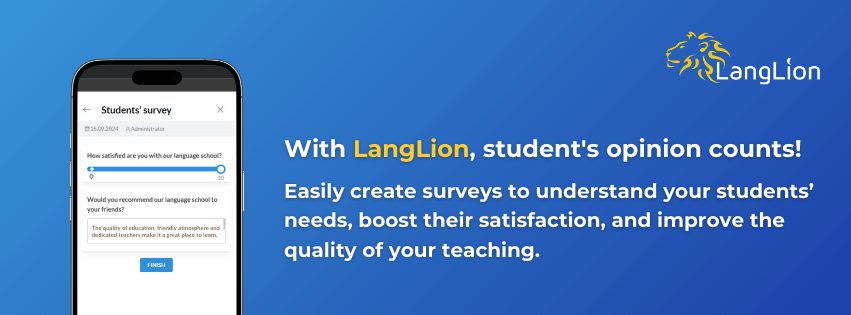
Student reviews hold immense value – they are one of the most effective marketing tools and an excellent way to continuously improve your offerings. The problem? Even the most satisfied participants rarely share their impressions. Why does this happen, and what can you do to change it? In today’s article, we offer tips on how to effectively encourage students to leave reviews – ensuring they do so willingly, honestly, and regularly.
What will you find in this article?
- Why are student reviews so important?
- When should you ask for a review?
- What else should you keep in mind?
- How to encourage clients to leave a review?
- When not to ask a client for feedback?
- What mistakes to avoid when collecting feedback?
- How to collect customer feedback?
- Summary – how to encourage students to leave feedback?
Why are student reviews so important?
Social Proof
Social proof, a concept often recognized by its English term, is a psychological phenomenon where people assume the actions of others to be correct and emulate them.
Reviews from other course participants act like recommendations from a friend. Thanks to them, potential clients feel more confident when making a purchase decision. Authentic comments show that your course works and delivers value.
The impact of reviews on sales and trust
When looking for a good place to dine during a vacation, we browse Google Maps and are influenced by reviews, comments, and star ratings. Good reviews build trust and student loyalty and support the sales process. Sometimes a positive review is what tips the decision in your favor.
Feedback for course improvement
Reviews are not just marketing tools but also development tools. Students can point out what needs improvement or further development, allowing you to continuously enhance the quality of your offerings.
Remember, this can be valuable information that can help you improve not just the course itself but also other critical areas, such as customer service in your school.

When to ask for a review?
There are two options – during the course or after its completion.
You don’t always have to wait until the end of the course! Fresh emotions and enthusiasm are a good time to ask for feedback, for instance, after completing a module or a specific section.
Nevertheless, the most common method is to ask for feedback after the course is completed.
What else should you keep in mind?
Automation of reminders
Automated reminders, such as email or SMS, can significantly increase the number of reviews submitted. However, it’s important that they are not too intrusive or frequent. You need to use such automation wisely to ensure it doesn’t backfire.
Think about what kind of review a student might give if they receive a message asking for course feedback every two days?
Personalization
Address them by name, refer to a specific moment in the course, or highlight a student’s achievement. A personalized message increases the chances of a response.
This is now a standard practice – not just in collecting feedback, but also in other marketing activities. It reduces distance, increases effectiveness, and builds a positive image of the school.
Target satisfied customers
Obvious, but worth emphasizing. Observe who actively participates, asks questions, shares successes, and most importantly – who is genuinely satisfied. This is the perfect moment to send an individual request for feedback.
If you care about positive reviews, direct your requests primarily to satisfied students!
How to encourage customers to leave reviews?
Show that feedback matters
Inform them that their feedback is important to you. Show quotes from reviews in newsletters, social media and on the course page.
Demonstrate that they have a real impact on the development of your offerings.
Bonus for opinion
You can propose a small bonus: an additional lesson, a discount on the next course, or an e-book. It’s important not to force a positive opinion but to show that it’s worth sharing.
Specific request – not „write a review”
It’s better to ask a specific question: „What did you like the most?”, „Would you recommend this course to others?”, „How did you like this section?”
This way, it will be easier and more natural for the student to describe what they were satisfied with. Expressing an opinion will come much more effortlessly.
Write a review… for the client!
Some students don’t know what to write – even with prompts. In such a case, offer help: prepare a draft review that the client can approve or modify. Most of the work will already be done, which will significantly ease the entire process.
What else motivates students to share their opinions?
- Authentic gratitude and relationship – when students feel that you genuinely care about their opinion, they are more willing to share their thoughts. Sincerity and openness always pay off.
- Acknowledging active participants – praise the student publicly, thank them via email. Appreciation motivates sharing opinions and builds engagement.

When not to ask a client for an opinion?
- Right after an unsuccessful experience – when a student had a problem or negative experience, first take care of their needs.
- When the client is clearly dissatisfied – in such a situation, it’s worth listening, offering help, or compensation. Requesting feedback can worsen the situation.
- Too early – if the course hasn’t started yet or the participant hasn’t had the chance to recognize its value, the request will be inappropriate.
What mistakes to avoid when collecting feedback?
First and foremost, avoid repeating the same message without a response. This might discourage or annoy the student and sometimes even result in negative feedback. It’s always worthwhile to thank for feedback, even if it’s brief. Silence is a missed opportunity to build relationships.
Negative feedback is an opportunity for improvement. Respond with grace, explain the situation, and show readiness to change.
How to collect client feedback?
- On the language school’s website – install a feedback widget, add a form, use pop-ups asking for a review.
- Google My Business Profile – this is a place where many customers leave reviews. Regularly remind them of the possibility to leave a review here.
- Recommendations on Facebook – encourage participants to leave recommendations on your social media, for example, in the form of a review on Facebook.
Summary – how to encourage students to leave reviews?
Encouraging students to share their reviews is a key element of the marketing strategy for any language school. Reviews serve as social proof, increase trust in the school, and have a real impact on the decisions of other students.
To effectively gather reviews, it is worth acting at the right time – ideally after the course ends. Schools can additionally encourage leaving reviews by offering help in writing them, granting bonuses for submission, sharing the review on the website and social media, personalizing the request, and asking specific questions instead of formulating a general inquiry.
Remember that an honest, even short review from a student is an invaluable marketing and developmental asset. It’s worth taking care of it with sensitivity and respect.
Want to know how to respond to reviews – even negative ones? Be sure to check our post on how to deal with negative online reviews!
